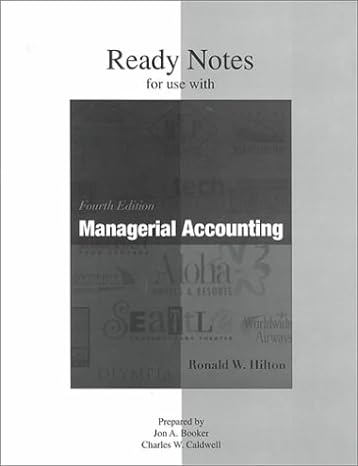Question
Question 1 A company operates a standard marginal costing system. Last month's actual fixed overhead expenditure was 2% below budget, and the fixed overhead expenditure
Question 1
A company operates a standard marginal costing system. Last month's actual fixed overhead expenditure was 2% below budget, and the fixed overhead expenditure variance was $1,250. What was the actual fixed overhead expenditure for last month?
a.
$62,500
b.
$62,475
c.
$61,250
d.
$63,750
Question 2
What is meant by "budgetary slack"?
a. The difference between the budgeted output and the actual output
b. The difference between budgeted capacity utilization and full capacity
c. The intentional overestimation of costs and/or underestimation of revenue in budget
d. The lead time between the preparation of the functional budgets and the approval of the master budget by senior management
Question 3
Operation S, in a factory, has a standard time of 15 minutes. The budget for a period was based on carrying out the operation 350 times. The standard rate of pay for operatives is $10 per hour. The standard time should have been reduced to 12 minutes. It was subsequently realized that the standard time for Operation S included in the budget did not incorporate expected time savings from the use of new machinery from the start of the period. Operation S was actually carried out 370 times in the period in a total of 80 hours. The operatives were paid $850.
What was the operational labor efficiency variance?
a. $60 Adverse
b. $75 Favourable
c. $100 Adverse
d. $125 Adverse
Question 4
The following sales were budgeted for the year:
Product A
Product B
Product C
Demand (units)
1,000
2,000
3,000
Selling price
$15
$20
$30
Profit per unit
$2
$5
$2
Actual sales for the year showed the following results:
Product A
Product B
Product C
Units sold
1,100
2,050
2,800
Sales value
$17,050
$38,950
$86,800
Profit
$3,080
$10,455
$6,160
What is the sales mix variance?
a. $2,292 Adverse
b. $1,845 Favourable
c. $200 Favourable
d. $50 Favourable
Question 5
The following statements have been made about logical access controls:
(1) It is never possible for logical access controls to stop all unauthorised attempts to access confidential data.
(2) They include the use of passwords.
(3) Their primary purpose is to stop unauthorised access to the data and software in a system.
Which of the statements above are true?
a. 1 and 2
b. 1 and 3
c. 2 and 3
d. All of the above
Question 6
Cappuccino Limited manufactures and hand paints cups for sale to the wholesalers. Two types of cups are sold, a small cup size for espresso and a larger cup for other kinds of coffee. The cup-making process can be simplified into formation, baking in an oven, and then finishing.
Time and cost analysis by the management accountant provides the following data:
Small ($)
Large ($)
Selling price/cup
3.80
6.60
Materials/cup
0.84
1.75
Forming time/cup
4 mins
6 mins
Baking time/cup
2 mins
3 mins
Finishing time/cup
5 mins
7 mins
The processes maximum capacities have been measured as follows:
Forming
Baking
Finishing
Production Capacity in period
120,000 cups
210,000 cups
95,000
cups
Productive time available in period
10,000 hours
10,000 hours
10,000 hours
Labor costs are all fixed, and these, along with other period costs, total $295,000.
i) What is the bottleneck process?
a. Forming
b. Baking
c. Finishing
d. They all have the same production time, so the process has three bottlenecks
ii) Assuming that finishing is the bottleneck, what is the throughput accounting ratio (TPAR) for the large product? (2 Marks)
Enter your answer here to 2 decimal places $ _______________
iii) Assuming Cappuccino Limited wanted to improve its TPAR ratios and that finishing remained the bottleneck, which two of the following tactics would be most effective and cost-efficient?
a. Invest in more forming capacity b. Double the number of shifts for all processes c. Double the number of shifts for the finishing process d. Negotiate a materials discount
iv) If TPAR fell below the value of 1 but remained positive, which two of the following statements could be made?
a. The product is loss-making
b. The product is still making a contribution c. Production of the product in question will cease d. For a profitable company, this is not possible
v) The assumption of just-in-time processing is an important feature of throughput accounting. Which of the options below are true for JIT?
a. It is only workable if a business can predict demand patterns.
b. It can often force suppliers to become surrogate stockholders.
c. Both above
d. None of the above
Step by Step Solution
There are 3 Steps involved in it
Step: 1

Get Instant Access to Expert-Tailored Solutions
See step-by-step solutions with expert insights and AI powered tools for academic success
Step: 2

Step: 3

Ace Your Homework with AI
Get the answers you need in no time with our AI-driven, step-by-step assistance
Get Started


